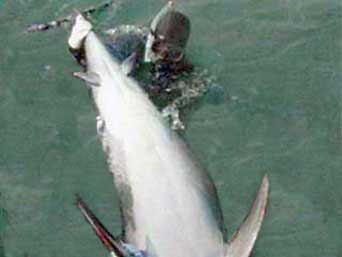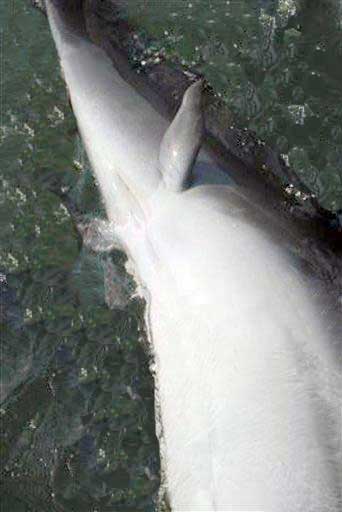Cetacean Evolution (Whales, Dolphins, Porpoises)
Evidence Of Common Ancestry of Cetaceans and Certain Species of Land Mammals
by Edward T. Babinski
Response to Answers in Genesis's Response on Dolphin Hind Limbs

TOKYO Nov 5, 2006 (AP), Japanese scientists reported a bottlenose dolphin, has an extra set of fins that could be the remains of hind limbs. The dolphin was captured alive in western Japan on Oct. 28, by Fishermen. "I believe the fins may be remains from the time when dolphins' ancient ancestors lived on land," said Seiji Osumi, of Tokyo's Institute of Cetacean Research. The hind fins are much smaller than the front fins and are about the size of human hands, protruding near the tail. The dolphin measured approx 9 feet in length.
- Dolphin May Have 'Remains' of Legs, Evidence Ocean Mammals Lived on Land
- A Dolphin with Hind Limbs, Science Blogs
- Dolphin May Have 'Remains' of Legs, Associated Press
- Answers In Genesis Response to Dolphin Hind Limb Discovery
- Hind Limb Buds on Pantropical Spotted Dolphin

I just read AIG's article, "Dolphin found with 'remains of legs' Should creationists surrender?" by Ken Ham and David Menton
November 5, 2006
In that article I noticed this paragraph in particular:
"While cetaceans (dolphins, porpoises, and whales) lack hind limbs, they have pelvic bones that differ in males and females and appear to support the reproductive organs. Whether they also have rudimentary femurs and other leg bones is less certain. For evidence of whale 'legs,' many evolutionists cite a paper published by Struthers in 1881 which purports to describe a rudimentary 'femur' in the adult Greenland Right-Whale (Balaena mysticetus)."
My response to the above paragraph is that
1) Your readers ought to be informed of AIG's changing views concerning whether or not ANY evidence of hind-limbs on cetaceans (ancient or modern), has ever been found. AIG tried to deny the evidence of modern day cetaceans found with remnants of hind limbs, and simply ignored the embryonic evidence found in ALL cetacean embryoes of hind-limb buds. Sarfati told me in an email that he would not even LOOK at the scientific articles I had collected concerning such evidence.
At first AIG even mocked the idea that the bones found near the genitalia of whales were indeed "pelvic" bones. Now it seems AIG is shifting its opinions. You admit above that they are "pelvic" bones. Bravo. But now you assert that the existence of "femurs" is "uncertain."
2) But the existence of "femoral" bones is not "uncertain" at all according to the world's leading cetacean scholars.
"The existence of a pair of small pelvic bones is known to exist in nearly all of the Cetacea...[and] in the Fin Whale, the Blue Whale, and the Humpback, the femur too is present near the pelvis. [Even in the Sperm Whale the femur is sometimes present (in the form of a small round-shaped bone near the pelvis).-E.T.B., there are photos at my website edwardtbabinski.us/whales] And in the Right Whale not only the femur but also the tibia exists. [An exhibit concerning Strutthers's dissections is on display at a museum. See photo of that exhibit at my website. - E.T.B.]." [Ogawa, R., and Kamiya, T. A. (1957) "Case of the Cachalot [Sperm Whale] With Protruded Rudimentary Hind Limbs." Scientific Reports of the Whales Research Insititute, No. 12, p. 197-208.]
Also note my earlier submission to AIG on this topic:
SUBMITTED TO "FEEDBACK" AT "ANSWERS IN GENESIS" 3/6/2006
In John Woodmorappe's article, "Walking whales, nested hierarchies, and chimeras: do they exist?" he added in a footnote, "...National Geographic mentions the fact that...the usually tiny ‘hindlimbs’ found in modern whales serve as anchors for the muscles of the genitalia. There is thus no compelling reason for considering the reduced hindlimbs, which occur in true cetaceans, as evolutionary leftovers of a terrestrial ancestry."
No compelling reason? How does he arrive at that conclusion? The fact that such hindlimbs serve as "anchors for the muscles of genitalia" is yet another reason to agree that we are speaking about a vestigial pelvis in the whale, because the pelvis in land mammals also provides "anchors for the muscles of the genitalia."
Secondly, the the embryos of ALL cetacean species (i.e., whales & dolphins) not only develop FRONT-limb buds that grow into their front limbs (limbs with finger bones and finger muscles like in land mammals, but the muscles have become skinny less flexible tendons); but all cetacean embryos ALSO develop HIND-limb buds that appear (then get reabsorbed in the embryonic stage)!
The question for creationists is why do hind-limb buds develop in all cetacean embryos if the idea of "hindlimbs" on a cetacean is something creationists continue to try and deny?
Modern cetaceans not only have pelvic bones, but some species also have femurs, while still others have a remnant pelvis, femur and TIBIA as well! Some such remnants on rare occasions even buldge or protrude from the cetacean's body! For photos just google: Cetacean Evolution Babinski
One species, the Right Whale, features remnants of femurs, tibias AND the synovial capsules around the joints connecting them to one another, exactly as expected if we are indeed talking about remnants of hind-limbs.
"One cannot help being convinced, as the dissection goes on, that these rudiments [in the Right Whale] really are femur and tibia. The synovial capsule representing the knee-joint was too evident to be overlooked. An acetabular cartilage, synovial cavity, and head of femur, together represent the hip-joint. Attached to this femur is an apparatus of constant and strong ligaments, permitting and restraining movements in certain directions; and muscles are present, some passing to the femur from distant parts, some proceeding immediately from the pelvic bone to the femur, by which movements of the thigh-bone are performed; and these ligaments and muscles present abundant instances of exact and interesting adaptation. But the movements of the femur are extremely limited, and in two of these whales the hip-joint as firmly anchylosed, in one of them on one side, in the other on both sides, without trace of disease, showing that these movements may be dispensed with. The function point of view fails to account for the presence of a femur in addition to processes from the pelvic bone. Altogether, these hind legs in this whale present for contemplation a most interesting instance of those significant parts in an animal -- rudimentary structures." [Struthers, John, M.D., Professor of Anatomy in the University of Aberdeen. (1881) "On the Bones, Articulations, and Muscles of The Rudimentary Hind-Limb of the Greenland Right-Whale (Balaena mysticetus)." Journal of Anatomy and Physiology (London), Vol. 15, p. 141-321.] Google: Cetacean Evolution Babinski
OTHER vestiges that point to the mammalian land ancestry of modern day cetacea (whales & dolphins) include:
1) Forelimbs that feature bones and finger-muscles as in land mammals but although the bones and muscles remain present the muscles are much reduced, largely non-contractile and act more in the fashion of ligaments.
2) Cetaceans have hearts with ventricles and auricles just like land mammals.
3) Cetaceans are warm-blooded like land mammals.
4) Cetaceans have lungs like land mammals.
5) Cetceans nurse their young like land mammals.
6) Cetaceans have eyelids that move as in land mammals.
Fin? Fin? Creation Ministries International (formerly Answers in Genesis) keep trumpeting that word as if the dolphin were a mere fish.
See for instance, "A dolphin with legs—NOT" by Carl Wieland
8 November 2006
They ignore that the dolphin is a mammal, hence its front appendage is a forelimb, not a "fin," but merely functions as a "fin." And its forelimb is composed of bones homologous to the arms and hands of its quadrupedal ancestors.
The absence today of hind limbs in dolphins and other living cetacean species serves as proof that even vestigial hind limbs are no longer needed for either guidance or copulation. Yet the fossil record shows that hind-limb rudiments were the RULE long ago when the first dolphin and cetaceans lived. And hind-limb buds can STILL be seen sprouting from the embryo in the same places as they do in other mammals, but in the case of the cetacea such buds are reabsorbed and do not develop into hind limbs, though sometimes the buds do become rudimentary hind limbs that have been found occasionally on modern day dolphins and other cetaceans, and those hind limb vestiges have been x-rayed and/or dissected and proven to contain vestigial bone and cartilage resembling femurs, and sometimes also contain vestigial femurs and tibias and synovial capsules between them, and sometimes they even contain femurs, tibias and some hand and fingerbones.
See the evidence at edwardtbabinski.us
- ETB


From ICR: One such evolutionary claim that has been around since the days of Darwin asserts that whales (which are mammals, not fish or reptiles) descended from some four-footed land mammal. Darwin thought that it was a bear-like animal that evolved into whales, but today evolutionists disagree. Some speculate that hoofed animals (like cattle) or wolf-like carnivores were the ancestors of whales. Others insist that DNA evidence indicates that the ancestors were hippopotamus-like. More recently, evolutionists claimed deer-like, raccoon-size animals had evolved into whales.
ReplyDeleteDespite their inability to identify which land mammal evolved into whales, evolutionists insist that fossils have been discovered that document this claim, making it a major talking point in the teaching of evolution. While it is true that there are similarities between all mammals, and a few fossils have been found in strata that have been “dated” in the proper “ages” (according to evolution) that seem consistent with such a story of transformation, is this story credible and is the fossil evidence sufficient? What would be the evolutionist’s answer to the “How do you know that to be true” question?
The whale ancestor most often cited is Pakicetus, a four-legged land animal somewhat like a wolf (Figure 1). In reality, the original fossil consisted of only the skull, and years later more partial bones were added. Yet the artists’ sketches of the creature show it swimming and catching fish. Is this convincing evidence of a pre-whale?
The next fossil supposedly spanning the transition is Ambulocetus natans, a swimming mammal. Again only partial remains were found, dispersed and shattered. What was recovered indicated that this animal was a powerful swimmer, propelling itself along much like a walrus. Like some other mammals, it spent time on both land and in the sea, but this does not make it transitional.
Finally, there is Basilosaurus, a 60 foot-long serpentine sea creature. Its fossils were first assumed to be those of a snake, not at all whale-like. A tiny 6-inch leg was discovered near one of the fossils, widely touted as proof this was a whale with legs. The association of the 6-inch leg with the 60-foot body is at least tenuous, and even if the association is correct, the legs would be totally inadequate for walking. Many evolutionists have concluded that, if genuine, they were more likely used as a guide and stabilizer in copulation.
A whale has so many seemingly designed features that are substantially different from any land or land/sea creature that the claim of a tetrapod evolving into a whale is simply not credible. Not only are the special organs and abilities too specific to be adaptations from a radically different creature, the proposed fossil transitions are not sufficient to make any such claim.
Asking probing questions will often expose weaknesses in evolutionary claims.1 Teachers appreciate legitimate questions from students, if asked in a respectful manner. They might even help the teacher (as well as the other students) recognize the obvious weakness in evolutionary “evidence” and help them to consider the alternative: God created all the creatures—including the spectacular whales—exactly as they are just as Genesis says.